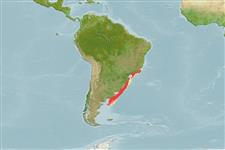Malacostraca |
Decapoda |
Scyllaridae
Environment: milieu / climate zone / depth range / distribution range
Ecology
Benthic; depth range 45 - 200 m (Ref. 4). Tropical; 7°S - 43°S, 63°W - 33°W (Ref. 4)
Western Atlantic: Brazil and Argentina.
Length at first maturity / Size / Weight / Age
Maturity: Lm ?, range 9 - ? cm Max length : 32.6 cm TL male/unsexed; (Ref. 106366); 36 cm TL (female)
It has carapce lengths of 5 to 12 cm (Ref.4). Found in depths between 45 and 200 m. Little is known about the substrate on which the animals live, except for one record from a sandy bottom (Ref. 4). In general, Scyllarides sp. inhabits the intertidal zone; many prefer rocky substrates while others are on muddy or sandy bottoms (Ref. 106789). Scyllarids are mainly carnivorous scavengers preferring small benthic invertebrates (Ref. 106995).
Mating behavior: Precopulatory courtship ritual is common (through olfactory and tactile cues); usually indirect sperm transfer (Ref. 833).
Holthuis, L.B. 1991. (Ref. 4)
IUCN Red List Status (Ref. 130435)
CITES status (Ref. 108899)
Not Evaluated
Not Evaluated
Threat to humans
Human uses
Fisheries: of no interest
| FishSource |
Tools
Internet sources
Estimates based on models
Preferred temperature
(Ref.
115969): 4.5 - 19.8, mean 8.7 (based on 59 cells).
